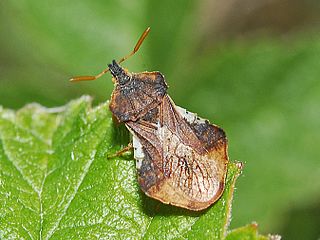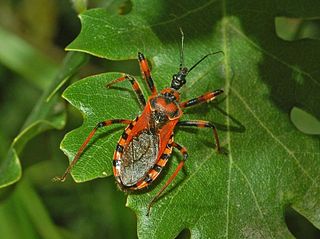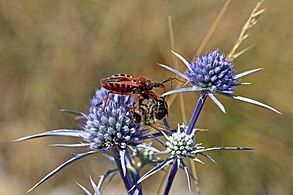
The Reduviidae is a large cosmopolitan family of the suborder Heteroptera of the order Hemiptera. Among the Hemiptera and together with the Nabidae almost all species are terrestrial ambush predators; most other predatory Hemiptera are aquatic. The main examples of non-predatory Reduviidae are some blood-sucking ectoparasites in the subfamily Triatominae, with a few species from South America noted for their ability to transmit Chagas disease. Though spectacular exceptions are known, most members of the family are fairly easily recognizable; they have a relatively narrow neck, sturdy build, and formidable curved proboscis. Large specimens should be handled with caution, if at all, because they sometimes defend themselves with a very painful stab from the proboscis.

Reduvius personatus or the masked hunter is an insect belonging to the assassin bug (Reduviidae) family. The name is because its nymphs camouflage themselves with dust. The masked hunter is a predator of small arthropods, including woodlice, lacewings, earwigs, bed bugs and termites. Masked hunters do not feed on human blood, but can sting humans in self-defense when mishandled. The sting can be painful, but masked hunters do not carry Chagas disease unlike the kissing bug for which they are sometimes mistaken.

The Harpactorinae are a large subfamily of the Reduviidae. About 300 genera and 2,000 species worldwide have been described. Some of the species of the genera Zelus, Pselliopus, Sinea, and Apiomerus are of interest as biological pest control agents.
Gardena is a genus of thread-legged bugs in the subfamily Emesinae. It is the second-largest genus in the tribe Emesini. Presently there are 46 described species.

Brontostoma is a neotropical genus of assassin bugs in the family Reduviidae. About 20 species have been described. These species are brightly colored with reds and oranges, and like all members of the Ectrichodiinae, specialize on millipede prey.

Rhynocoris is a genus of assassin bug, family (Reduviidae), in the subfamily Harpactorinae. Species are recorded from Asia, mainland Europe, Africa and North America.
Rhynocoris tristis is a species of assassin bug family (Reduviidae), in the subfamily Harpactorinae. R. tristis is a polyphagous predator found in sub-Saharan Africa.

Rhynocoris albopunctatus is a species of assassin bug family (Reduviidae), in the subfamily Harpactorinae. It is common in cotton plantations, especially near pastures where Stylosanthes gracilis is incorporated.

Dulichius inflatus is an ant mimic bug in the family Alydidae that is found mainly in southern India and Sri Lanka. It is said to live in the nests of ants Polyrhachis lacteipennis which it morphologically resembles.

Sphedanolestes cingulatus is a species of assassin bug belonging to the family Reduviidae, in the subfamily Harpactorinae.

Phymata crassipes is a species of assassin and thread-legged bugs belonging to the family Reduviidae, subfamily Phymatinae.

Rhynocoris rubricus is a species belonging to the family Reduviidae, subfamily Harpactorinae.
Triatoma indictiva is an arthropod in the assassin bug family of Reduviidae, and is an important vector of Trypanosoma cruzi. T. cruzi is the protozoan that causes Chagas Disease, which affects approximately eight million people a year in the western hemisphere alone. Triatoma indictiva is found in Mexico and throughout the southern United States, including Arizona and Texas.

Rhaphigaster is a genus of stink bugs in the family Pentatomidae. Its most well-known member is the mottled shieldbug, Rhaphigaster nebulosa.

Phymata is a genus of assassin bugs belonging to the family Reduviidae, subfamily Phymatinae, commonly called jagged ambush bugs. They can be a variety of colors, with their coloring helping them camouflage with the plants they live on. They are predators.

Rhynocoris ventralis is a species of assassin bug in the family Reduviidae. It is found in North America.

Rhynocoris leucospilus is a species of assassin bug in the family Reduviidae. It is found in Europe, northern Asia and North America.

Nagusta goedelii is a species of assassin bugs in the family Reduviidae.
Rhynocoris longifrons is a species of assassin bug in the family Reduviidae. It is a predator of other insects and is found in Asia. Crops on which it is found feeding on pests include pigeon pea, cardamom and peanuts. The insects are potentially useful in biological control because they are more resistant to pesticides than are the pests they consume.
Rhynocoris marginatus is a species of assassin bug in the family Reduviidae. It is a predator of other insects and is found in Asia. Crops in India on which it has been found feeding on pests include sugarcane, pigeon pea, cardamom, cotton, tea, and peanuts. The insects are potentially useful in biological control because they are more resistant to pesticides than are the pests on which they feed.














